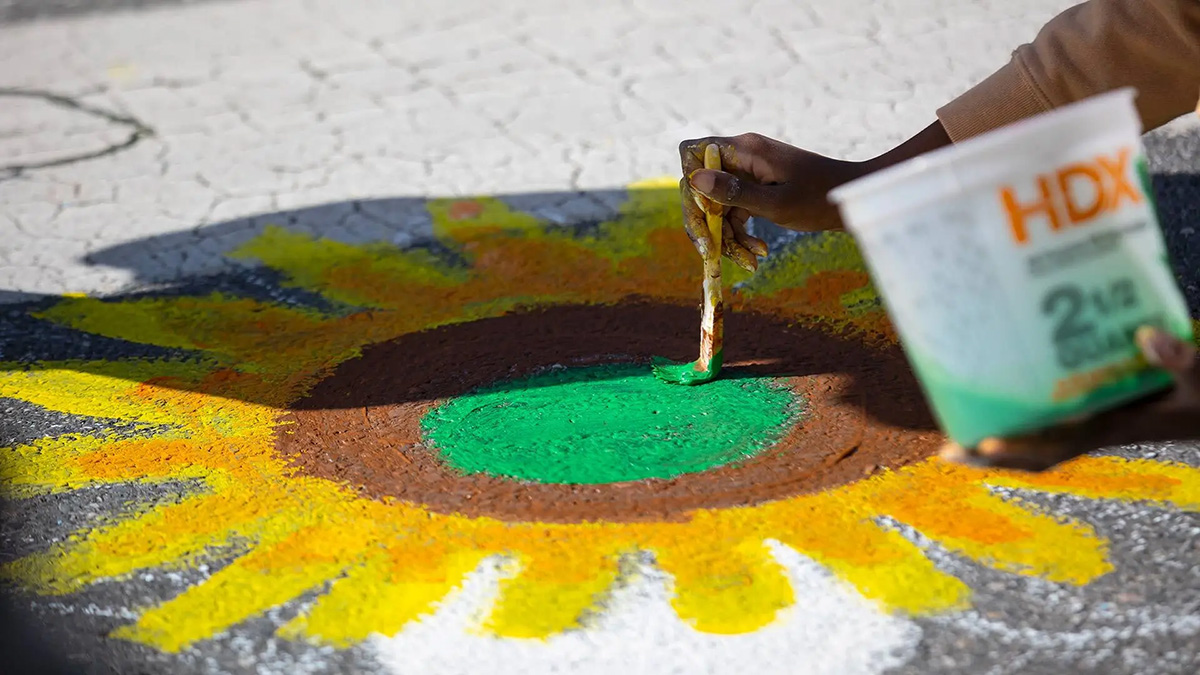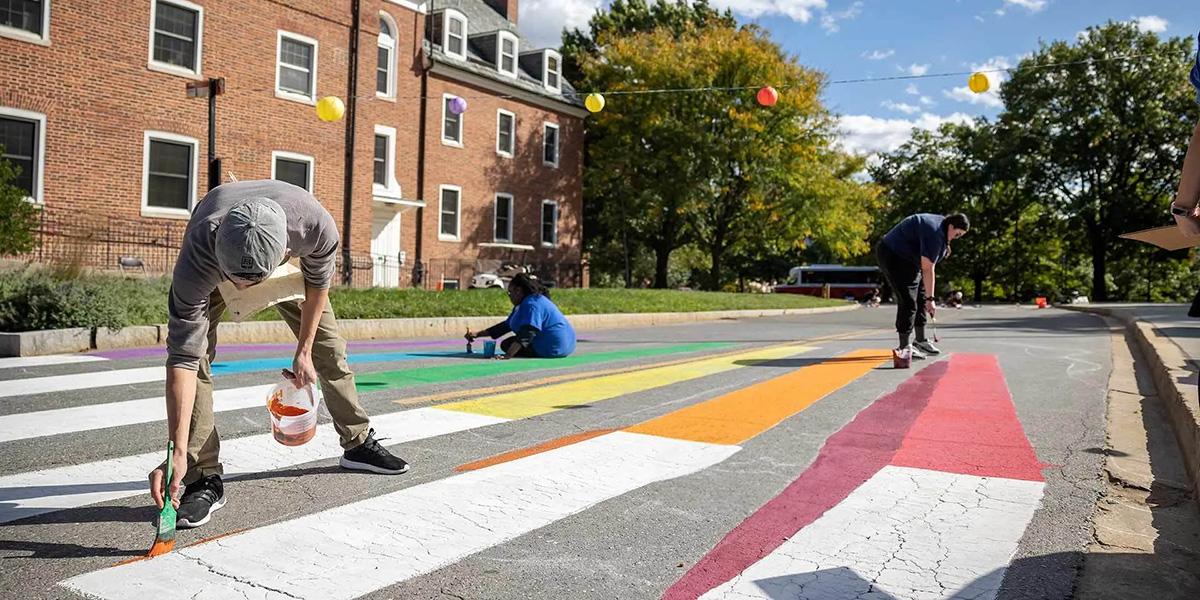This article originally appeared in Maryland Today.
The buzz around Tawes Plaza on Monday morning isn’t the sound of students’ cellphones or whizzing electric scooters, it’s what’s underfoot: a vibrant mural of bees floating between black-eyed Susans and sunflowers.
The Insta-worthy asphalt art is one of seven crosswalk murals created Sunday at Chalk the Walk, the University of Maryland’s first community “paint-in” festival sponsored by the Department of Transportation Services (DOTS), aimed at enlivening campus while calming oncoming traffic.
Led by art and architecture students in UMD’s creative placemaking minor, the project temporarily transformed a high-traffic area of campus to test the impact of ground murals on pedestrian safety; it’s part of the university’s Arts for All initiative, an experiential curriculum that partners the arts with other disciplines to nurture different ways of thinking to spark dialogue, understanding problem-solving and action.
“The ultimate goal for DOTS is to influence travelers to slow down and look up,” said Marta Woldu, assistant director of sustainability for DOTS. “The streetscape is activated with the creative work that these students are doing; the roadway becomes more people-oriented, not just a space for transporting vehicles.”
DOTS, Professor Ronit Eisenbach, and painter and art lecturer Benjamin Edwards mobilized 16 undergraduate students to create and execute whimsical mural designs, colorful enough to catch a driver or rider’s eye, while also adding something meaningful to campus; the fact that the event was held the day before Indigenous Peoples Day informed many of the concepts.
Students from Eisenbach’s “Introduction to Creative Placemaking” course observed the plaza in September to note how many pedestrians, cars, bikes and scooters travel through the area. With the murals in place, the students will return this week to observe whether they change how people and vehicles engage with the space, such as reducing vehicle speeds or jaywalking. These temporary placemaking tactics, said Eisenbach, are a great way to test an intervention before making it permanent.
“What I love about this project is it’s not just beautifying a space, it’s also addressing a particular need and solving a problem through community participation, art, design and delight,” said Eisenbach, who directs the minor. “When people return, and see this amazing transformation, it’s going to be magical.”
Naya Doyle '26, an architecture major from Manassas, Va., paints the center of a sunflower as part of the Chalk the Walk art installation

Three of the crosswalks were left as blank palettes for passersby wanting to join in on the fun, with large stencils created by the students to help shape their designs. Music, food, dancing, and giveaways created a party-like atmosphere.
“It has really got me thinking about ways that people can feel a connection to their community and be-hands on,” said architecture student Cydney Walton ’24. “Your environment shapes your entire life. While the event is creating these safety interventions, it’s also really just nice to add this playful aspect to your day, whether you’re painting or just come across it this week.”
Street mural installations are gaining traction in cities around the world as a method for slowing vehicle speeds and creating safer environments for pedestrians. A 2022 study by the Bloomberg Philanthropies’ Asphalt Art Initiative, which has funded 42 street murals across the country since 2019, found more than a 50% decrease in accidents after the installation of crosswalk art and a 27% increase in motorists yielding to pedestrians.
At Maryland, the installations also aim to slow the thousands of bikes and scooters that share campus roads with pedestrians and vehicles. In addition to Chalk the Walk and other activities planned for Safety Month, DOTS is launching a feasibility study this month for separate bike/micromobility lanes on major campus corridors.
Riders and walkers making their way down Preinkert Drive this week will encounter curvy pathways, a multicolored optical illusion, flower beds and bold graphic shapes, beckoning students to slow down and look around on their way to class or grab a selfie. A beautiful addition to campus, it is also—for now—temporary: Created with water-soluble paint, the murals will last until the next storm moves through College Park.
“While this is temporary, I hope that we are sparking these sorts of conversations to start thinking about what we do and how artists can help decision makers create a more shared space on campus through art in the right of way,” said Aysha Cohen, DOTS sustainable transportation coordinator.

